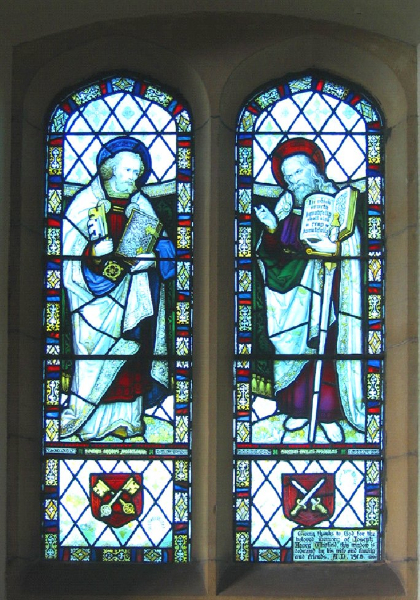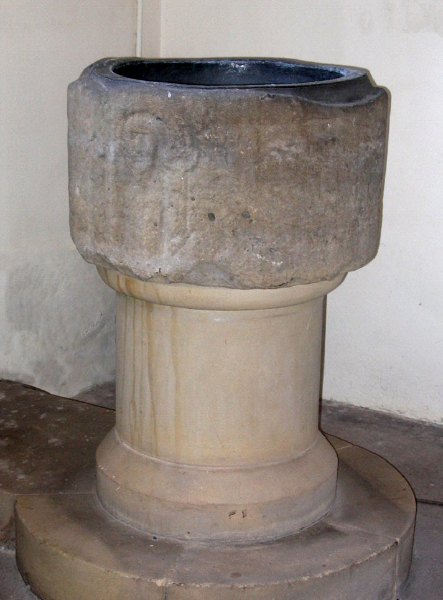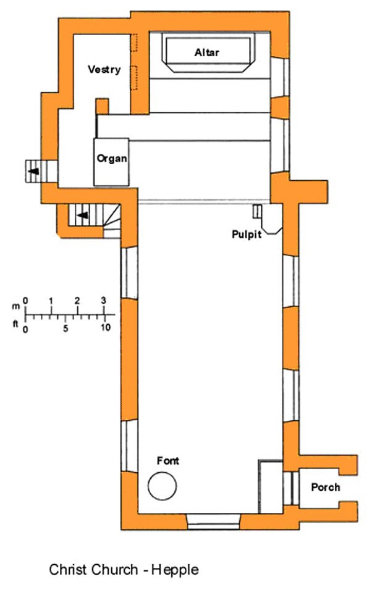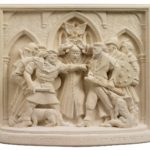Christ Church, Hepple
The Village and Parish
Until the Poor Law Act of 1597, civil parishes and ecclesiastical parishes were the same. Since the Act was passed the two have acquired separate identities. Hepple has its own civil parish with its own local parish council. Until 2004 it was within the ecclesiatical parish of Rothbury in the diocese of Newcastle upon Tyne, but in 2004, the ecclesiastical parishes in the valley were merged to become the parish of Upper Coquetale, in which the chuch at Hepple is one of six.

In former times, Hepple was the most important lordship within Rothbury parish. In 1265, Rothbury was part of “de barony de Heppedale,” reporting directly to the King, Henry III. Its lords possessed legal powers, inculing a gallows and a prison, which were not held by any other manor in the parish, except the lordship of Rothbury itself. After passing through the hands of several barons, in the early 19th century the title was acquired by the Buchanan Riddles, still resident in the parish today at Hepple Whitefield. This has been the seat of the baronetcy of the family since it was acquired from the Duke of Portland in 1804 by Sir John Buchanan Riddell, 9th baronet. The family has continually served the church, parish and country with distinction in both civil and military activities.
The village of Hepple was first recorded in the 13th century. A reference from 1724 noted that the village included a number of “castle houses’ most probably stout walled bastles in which livestock could be herded into the lower floor while the upper floor was for human occupation. These bastles were built up to at least the 17th century, particularly useful in the 12th and 13th centuries when invasion by the Scots was most common. For many years, the valley was rarely free from violence.
 Hepple Tower at the east end of the village was a 14th century defensive tower house. Today it is a complete ruin, but it is considered possible that it was originally three storeys high.
Hepple Tower at the east end of the village was a 14th century defensive tower house. Today it is a complete ruin, but it is considered possible that it was originally three storeys high.
Over the years there was an involvement in mining in the parish, particularly for coal, clay, iron, and of course stone for building. These activities ceased many years ago.
The remains of old buildings were discoverd to the west of the village in the early 19th century, and were considered to be part of a mediaeval settlement. All evidence of these buildings have now disappeared.
Two mediaeval grave covers and a footstone lie just north of Christ Church.
Churches in the past
From the various remains that have been found, there appears to have been a chapel at Hepple, on a hill called Kirk-hill, near West Hepple, the remains of which were removed about 1760, in order to build a farmhouse. Until this time the chapel was occasionally used as a burial place by five of the adjoining villages. When its remains were removed, a font and the pedestal were in a well preserved state, and remnants of monuments were found both within and outside the walls of the building.

It was probably of mediaeval date, though the font believed to be from this site may be of the later Anglo-Saxon origin. It is not known with any certainty when it became out of use, though it was known to be in ruins by 1725. However people were still being buried in the adjacent graveyard until the mid-18th century. The chapel may have been destroyed by the border reivers. In the 19th century a stone cross stood in the field recording the site of the chapel. By this time even the ruins of the building had disappeared, and the cross has now gone too. Excavations in 1972 found the remains of a rectangular nave with a square-ended chancel. The tomb of Lady Marjorie Tailboise, known to be alive in 1226, was found west of the chancel steps.
Only a few yards from the site of the former chapel is the site of a Bronze Age cremation cemetery. At least eight pots have been found in this area. Two were found in one stone-lined grave, the other graves had one pot each. These burials were found in 1821 and pots were also located in 1862. Further pots were found during archaeological excavations in 1971, along with the remains of three adults and a child.
The present church
Sir Walter Buchanan Riddell, the 10th baronet holding the title, died in 1892, and in his will left some money for the purpose of building a church and a school at Hepple. This sum was supplemented by his nephew and successor, Sir John Walter Buchanan Riddell, who also gave the site on which the church is built, and an acre of land as a burial ground. The school, designed to accommodate 80 pupils, was built on the opposite side of the road. The school closed in 1969 and it is now used as the village hall.
The church and burial ground were consecrated June 5th, 1897, by the first Lord Bishop of Newcastle, Ernest Roland Wilberforce. The church was designated as a chapel-at-ease within the ecclesiastical parish of Rothbury. A brass plate in the wall near the pulpit bears the following inscription :—“ To the Glory of God, the honour of His Church, and in Memory of Sir Walter Buchanan Riddell, Bart., The Pious founder of Christ Church and the School at Hepple. Born 1810, died 1892; May he rest in eternal peace.”
Building was carried out by C. Hodgson Fowler using local stone with simple mullioned windows with plain glass in the north and south windows, decorative glass in the west window, but otherwise with very little ornamentation. There is a nave, a chancel, with a vestry and organ chamber on the north side of the chancel, and a south porch at the west end of the nave. The style of the building is related to the “perpendicular” style, based on the design of other churches of that style in the local area.
While the plinth of the font is relatively modern, the bowl is from the Norman period, found near the site of the old Hepple Chapel at West Hepple. Set into the north wall above the font is a section of a 14th century stone grave cover with an unusually decorated cross. Standing freely near the font is the head of a stone cross, found on the moors to the west of Hepple. It is believed to be a boundary cross, marking the boundary beween the parishes of Hepple and Holystone.
There is one bell in the timber and slate bell tower which is situated between the nave and chancel. It is one which was removed from Rothbury church when the present peal of eight bells was installed there in 1893. Inscribed on the bell is the makers’ name: “C. & G. MEARS, FOUNDERS, LONDON, 1850.”
The organ was built in 1897 by Atterton and Son of Leighton Buzzard, and apart from having been fitted with an electric blower is in the same state as when it was acquired. It has two manuals and a pedal board, with a total of nine speaking stops.
On entering the church, attention is firstly drawn to the timber barrel vaulted roof and the highly colourful decoration. Through the wooden chancel arch and the three Tudor style arches in the screen is seen the reredos and altar, highly decorated in an Italian style and in the eyes of many people unexpected in a church or location of its type. There is no east window. The reredos was installed in 1903 and contains paintings depicting the Annunciation and Passion, the latter being a copy of Perugio’s painting in Florence. It was painted by a Miss Boothby. The altar dates from 1934. The altar and its surroundings were all given in memory of Walter Robert Buchanan Riddell, the 12th baronet, as shown on the memorial plaques in the church.
There are several memorial plaques and tablets on the south wall of both nave and chancel in remembrance of various members of the Buchanan Riddell baronets and their families.
Since the dedication of the building, two stained glass windows have been installed. On the south wall of a chancel is one dedicated to Henry Edward Buchanan Riddell who died in 1900, and on the north wall of the nave is another dedicated to the memory of Joseph Henry Whitfield who died in 1918. The clear glass windows in the south wall were recently reglazed, and blessed on 18th March 2007. They were a gift of the present baronet, Sir John Buchanan Riddell. The work was carried out by Iona Glass of Warkworth.

